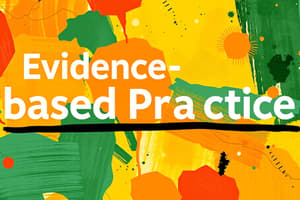Podcast
Questions and Answers
What was the primary focus of the large-scale study conducted by Lattimer et.al (2000)?
What was the primary focus of the large-scale study conducted by Lattimer et.al (2000)?
- The effectiveness of psychological assessments
- Patient satisfaction with GP visits
- Safety of nurse-led telephone triage (correct)
- Management strategies in nursing
Which aspect of Lattimer et.al (2000) distinguishes it from other studies in the field?
Which aspect of Lattimer et.al (2000) distinguishes it from other studies in the field?
- It utilized a large sample size to identify rare adverse events. (correct)
- It was limited to a single geographic location.
- It focused exclusively on patient demographics.
- It was the first study on the impact of telemedicine.
What is one of the advantages of the CASP tool mentioned?
What is one of the advantages of the CASP tool mentioned?
- It is designed specifically for qualitative research.
- It guarantees the validity of study outcomes.
- It helps in organizing thoughts and information. (correct)
- It eliminates research biases completely.
What limitation should be considered when appraising a study according to CASP tools?
What limitation should be considered when appraising a study according to CASP tools?
What is a key question to assess the generalizability of a study's findings?
What is a key question to assess the generalizability of a study's findings?
What should be stated clearly at the end of the background section of a research project?
What should be stated clearly at the end of the background section of a research project?
Which research framework helps formulate the research question?
Which research framework helps formulate the research question?
How many research objectives should typically be included in a project?
How many research objectives should typically be included in a project?
Which of the following best describes the aim of a research project?
Which of the following best describes the aim of a research project?
What is a critical component of the literature review framework?
What is a critical component of the literature review framework?
In the context of developing a research question, what does 'Population' refer to?
In the context of developing a research question, what does 'Population' refer to?
Which of the following is NOT a part of a critical review in the literature review?
Which of the following is NOT a part of a critical review in the literature review?
What should follow the aim in a research project?
What should follow the aim in a research project?
Which of the following terms is used to define the population in the PICO criteria?
Which of the following terms is used to define the population in the PICO criteria?
What is one alternate term for the intervention in the study's search criteria?
What is one alternate term for the intervention in the study's search criteria?
Which outcome is associated with the key term 'adherence' in the PICO criteria?
Which outcome is associated with the key term 'adherence' in the PICO criteria?
In the PICO framework, which of the following would NOT be considered an alternate term for the population?
In the PICO framework, which of the following would NOT be considered an alternate term for the population?
Which term represents an aspect of 'self care' in the context of diabetes management?
Which term represents an aspect of 'self care' in the context of diabetes management?
What method is suggested for collecting references while managing studies?
What method is suggested for collecting references while managing studies?
Which of the following is a tool used for systematic reviews in the research process?
Which of the following is a tool used for systematic reviews in the research process?
Which content area focuses on the goals of improving diabetes management through education and support?
Which content area focuses on the goals of improving diabetes management through education and support?
What is the main aim of the study conducted by Kruger and Guthrie?
What is the main aim of the study conducted by Kruger and Guthrie?
Which group received hands-on teaching sessions as part of the intervention?
Which group received hands-on teaching sessions as part of the intervention?
What type of educational material was provided to the comparator group?
What type of educational material was provided to the comparator group?
What follow-up duration was used to evaluate the effectiveness of the podiatric education?
What follow-up duration was used to evaluate the effectiveness of the podiatric education?
Which of the following foot health actions was part of the study's intervention?
Which of the following foot health actions was part of the study's intervention?
How many participants were in the experimental group?
How many participants were in the experimental group?
What did the study suggest might be influenced by the podiatric education?
What did the study suggest might be influenced by the podiatric education?
Which of the following locations was identified as the geographical context of the study?
Which of the following locations was identified as the geographical context of the study?
What is the primary aim of the session led by Dr. Joanne Paton?
What is the primary aim of the session led by Dr. Joanne Paton?
Which of the following is NOT one of the learning outcomes for the SoHP503 module?
Which of the following is NOT one of the learning outcomes for the SoHP503 module?
What is a critical component of the literature review section in a research project?
What is a critical component of the literature review section in a research project?
What should be included in the background and rationale of the proposed study?
What should be included in the background and rationale of the proposed study?
How far back should the literature searches generally be limited for the assignment?
How far back should the literature searches generally be limited for the assignment?
In what format should the introduction of the project be presented?
In what format should the introduction of the project be presented?
What is the purpose of identifying a research gap in the literature review?
What is the purpose of identifying a research gap in the literature review?
Which of the following is required in a literature review?
Which of the following is required in a literature review?
What was the primary conclusion of Vine's 2005 study regarding nurse led telephone triage?
What was the primary conclusion of Vine's 2005 study regarding nurse led telephone triage?
How did patients express their preferences regarding nurse led consultations?
How did patients express their preferences regarding nurse led consultations?
What aspect did Greenhalgh's seminal study focus on in its examination?
What aspect did Greenhalgh's seminal study focus on in its examination?
What significant limitation was noted in Greenhalgh's study on nurse substitution?
What significant limitation was noted in Greenhalgh's study on nurse substitution?
What was a key finding of Lattimer et al (2000) regarding nurses?
What was a key finding of Lattimer et al (2000) regarding nurses?
In what context did Vine's study become a respected work in nursing?
In what context did Vine's study become a respected work in nursing?
What is NOT mentioned as an outcome measure in Greenhalgh’s study?
What is NOT mentioned as an outcome measure in Greenhalgh’s study?
What aspect of nurse-led care did patient preferences indicate?
What aspect of nurse-led care did patient preferences indicate?
Flashcards
Literature Review
Literature Review
A comprehensive analysis of existing research on a topic, providing context, identifying gaps in knowledge, and justifying the need for new research.
References
References
The information used to support a claim or argument in a research paper.
Rationale
Rationale
A concise and focused summary of the reasons why a particular research project is important and relevant.
Research Question
Research Question
Signup and view all the flashcards
Critiquing Literature
Critiquing Literature
Signup and view all the flashcards
Search Strategy
Search Strategy
Signup and view all the flashcards
Research Gap
Research Gap
Signup and view all the flashcards
Impact of Research
Impact of Research
Signup and view all the flashcards
PICO
PICO
Signup and view all the flashcards
PEO
PEO
Signup and view all the flashcards
Search terms
Search terms
Signup and view all the flashcards
Population (PICO/PEO)
Population (PICO/PEO)
Signup and view all the flashcards
Intervention/Exposure (PICO/PEO)
Intervention/Exposure (PICO/PEO)
Signup and view all the flashcards
Comparison (PICO)
Comparison (PICO)
Signup and view all the flashcards
Outcome (PICO/PEO)
Outcome (PICO/PEO)
Signup and view all the flashcards
PubMed
PubMed
Signup and view all the flashcards
Research Rationale
Research Rationale
Signup and view all the flashcards
Research Aim
Research Aim
Signup and view all the flashcards
Research Objectives
Research Objectives
Signup and view all the flashcards
PICO Framework
PICO Framework
Signup and view all the flashcards
Conclusion of a Literature Review
Conclusion of a Literature Review
Signup and view all the flashcards
Identifying Search Criteria and Key Terms
Identifying Search Criteria and Key Terms
Signup and view all the flashcards
Study aim
Study aim
Signup and view all the flashcards
Intervention group
Intervention group
Signup and view all the flashcards
Comparator group
Comparator group
Signup and view all the flashcards
Foot health actions
Foot health actions
Signup and view all the flashcards
Healthcare setting
Healthcare setting
Signup and view all the flashcards
Number of participants
Number of participants
Signup and view all the flashcards
Year of study
Year of study
Signup and view all the flashcards
Authors
Authors
Signup and view all the flashcards
Cohort Study
Cohort Study
Signup and view all the flashcards
Case Control Study
Case Control Study
Signup and view all the flashcards
Randomized Controlled Trial (RCT)
Randomized Controlled Trial (RCT)
Signup and view all the flashcards
Economic Evaluation
Economic Evaluation
Signup and view all the flashcards
Systematic Review
Systematic Review
Signup and view all the flashcards
Seminal Studies
Seminal Studies
Signup and view all the flashcards
Comparable Performance
Comparable Performance
Signup and view all the flashcards
Doctor-Nurse Substitution
Doctor-Nurse Substitution
Signup and view all the flashcards
Safety of Nurse-Led Telephone Triage
Safety of Nurse-Led Telephone Triage
Signup and view all the flashcards
Large Sample Size
Large Sample Size
Signup and view all the flashcards
Vine (2005) Study
Vine (2005) Study
Signup and view all the flashcards
Greenhalgh (1994) Study
Greenhalgh (1994) Study
Signup and view all the flashcards
Closer Examination of Study Detail
Closer Examination of Study Detail
Signup and view all the flashcards
Study Notes
Lecture 3: Perform a Comprehensive Literature Search (SoHP503 Project Studies)
- The lecture is about performing a comprehensive literature search for SoHP503 Project studies
- The aim is to learn how to search, identify, read and critique the best available and most relevant reviews, papers, and journals related to undergraduate research topics.
- Learning outcomes include: judiciously selecting studies, assessing strengths and weaknesses of various studies, systematically searching relevant research literature, and comparing/contrasting empirical findings across multiple studies.
- A literature review is vital for the introduction and background of a project.
- The review must persuade the reader of the research's worth and refine the research question.
- The review requires references.
- A search strategy (e.g., PICO) does not need to be included in the proposal. It can be in an appendix.
- The background and rationale should encompass an introduction to key areas, context, research gaps, impact of research, rationale for the project, and a clear statement regarding research impacts, aims, and objectives.
- A research question (using PICO or similar), one research aim, and 2-5 research objectives are needed.
Literature Review Framework
- A general introduction for providing context is necessary including a development of research rationale, a critical review of literature, and a conclusion.
- Critical appraisal of relevant studies (published within the last 10 years) needs to include a brief description of studies, specifically the study's aim, sample size, methods, and main findings.
- The critical review should not simply describe, but should critique aspects like validity, reliability, and the methodology of the studies in question. It should explore potential implications.
- A conclusion that justifies the need for the study is required.
- A clear aim, a statement of the research intention, is needed.
- The research question should follow PICO (or a similar structure) to help guide the research.
Step 1: Identify your research topic area
- Identify your research topic. An example is: Does diabetic footcare education improve self footcare in people with diabetes.
- Conduct preliminary research by checking the internet and finding some relevant information.
Step 2: Identify your search criteria and key terms (PICO/PEO)
- Use a structured approach using PICO/PEO for your search criteria
- Organize these into a table using key terms and alternative terms.
- Includes an example table
Step 3: Search for studies
- Use electronic databases including PubMed, MEDLINE, CINAHL, AMED, Embase, Cochrane Database of Systematic Reviews, and PsycINFO.
- Use EndNote Online and the library guide for effective management of references and full text documents.
- Use the University of Plymouth Primo search tool.
Step 4: Data extraction
- From the studies you've located, extract relevant information.
- Look at factors like the healthcare setting, study aims, methods, key findings, etc. in order to describe the participants.
Step 5: Evaluate and critical appraisal
- Critically appraise the literature that has been collated.
- The aim is to synthesize the findings through comparing/contrasting relevant studies identified.
- Use a model to facilitate critical thinking and evaluating identified literature.
- The process involves description of the subject using 'Who?, Where?, When?, What?, Why?, How?, What if?, So What?, What next?', and 'Evaluation'.
Step 6: Plan your review
- Employ a linear representation of critical analysis to develop the review.
- Begin with questions like the context, background, participants, etc in relation to your study.
Step 7: Writing
- Develop a writing plan including all necessary stages for drafting and editing.
- Include a clear understanding of pre-writing and revision techniques.
Additional Considerations
- Consider the clinical benefit of your research question in relation to your study.
- Any questions can be directed to the discussion board.
Studying That Suits You
Use AI to generate personalized quizzes and flashcards to suit your learning preferences.




